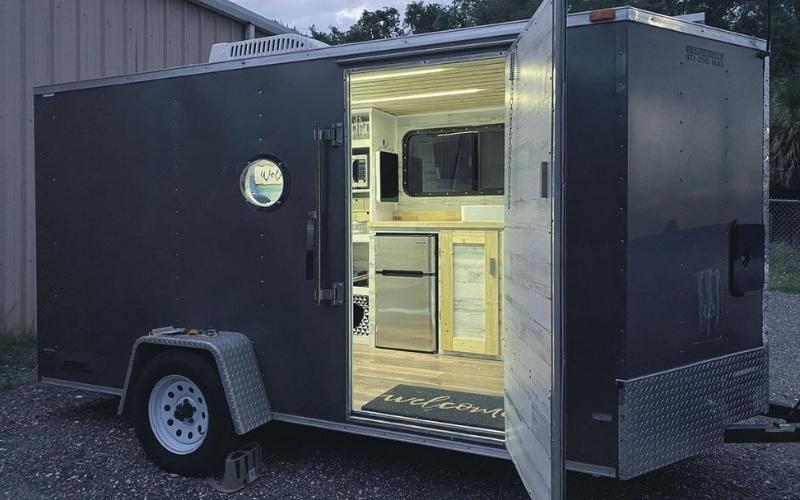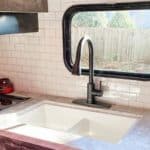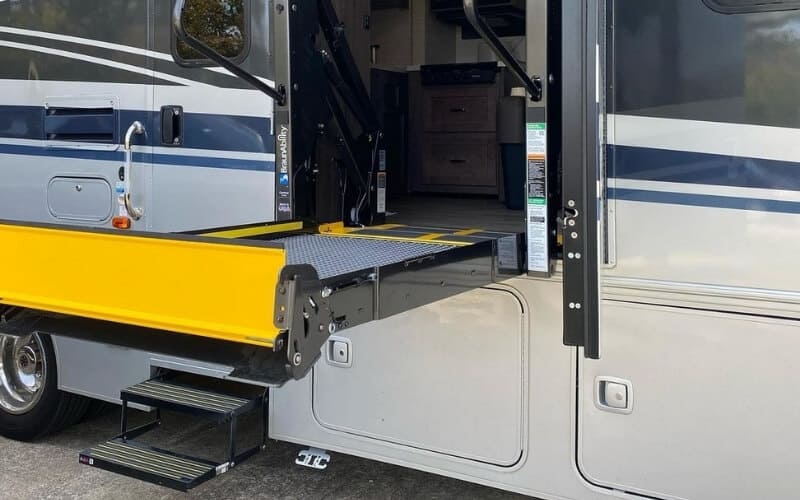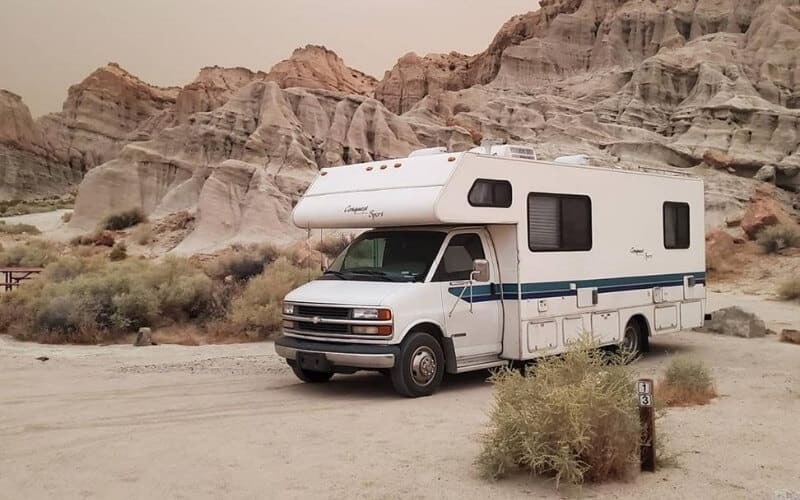Converting a cargo trailer into a camper offers a flexible and budget-friendly way to hit the road. With some DIY skills and planning, you can customize an enclosed trailer into a cozy home on wheels suited to your needs. We created this comprehensive guide that covers everything about cargo trailer camper conversions.
TL;DR:
- Benefits include lower cost, lighter weight, custom layouts, and toy hauling capabilities compared to traditional RVs.
- Costs range from $5,000-$15,000 depending on size, components and DIY vs professional conversion.
- Critical steps include checking the frame, tires, bearings and suspension before starting. Upgrade as needed.
What is Cargo Trailer to Camper Conversion
In short, cargo trailer conversion involves transforming an empty enclosed trailer into a customized camper by adding sleeping quarters, kitchenettes, lighting, plumbing, etc. The blank canvas allows RVers to tailor it to their exact travel style.
Benefits of Cargo Trailer to Camper Conversion
Converted cargo trailers offer many advantages over traditional RVs. Enclosed cargo trailer camper conversions allow RVers to fully customize the interior layout to match their exact needs and travel style.
- Lower Cost: Cargo trailers are cheaper to buy, used or new. DIY conversion also costs less than buying a finished camper. Savings allow more features.
- Lighter Weight: Enclosed trailers weigh less than comparably sized travel trailers, making them easier to tow with better fuel efficiency.
- Custom Layouts: The blank canvas allows the creation of specific living spaces to match your needs instead of a generic floor plan.
- Toy Hauling Capabilities: Many utilize cargo trailers with ramp doors to transport motorcycles, ATVs, snowmobiles, etc. Portable loading ramps are another option.
- More Headroom: Trailers offer ample height for comfortable standing and moving around.
Costs of Cargo Trailer to Camper Conversion
Expect to spend $5,000-15,000 converting a cargo trailer into a camper. Used trailers can cost $1,000-$2,500, while new 6×12 trailers run $4,000-$5,000. Self-converted vs professionally built campers fall on the lower and higher ends of the budget range, respectively.
Here’s a breakdown of costs for common trailer sizes:
| Trailer Size | Conversion Cost |
| 5×8 | $5,000 – $8,000 |
| 6×10 | $8,000 – $12,000 |
| 6×12 | $10,000 – $15,000 |
| Gooseneck cargo | $15,000+ |
DIY Cargo Trailer Camper Conversion
Cargo Trailer Camper Conversion Kits
Essential materials and tools needed include:
- Lumber: 2x4s and plywood to frame walls and build cabinets. Recommend moisture-resistant pine boards.
- Insulation: Fiberglass batts or rigid foam boards to insulate walls and ceilings.
- Fasteners: Wood screws, bolts, and adhesive for securing camper components.
- Protective Gear: Respirators, ear/eye protection for cutting materials during the build-out.
- Common Tools: Hammer, drill, saws, levels, tape measure and other workshop tools.
- Plumbing Parts: PVC pipes, toilet, sinks, pump, and water heater for freshwater system.
- Electrical: High-capacity 12V batteries, wiring, monitor, shore power inlet for power system.
- Appliances: RV / boat refrigerators, stove, microwave etc., for the kitchen area.
- Environmentally Friendly: Use zero-VOC paints/ finishes and sustainable furnishings when possible.
Once you have all the materials, follow these key steps:
Step 1: Choose Your Trailer
Inspect the frame, suspension, tires and bearings if buying a used enclosed trailer. Upgrade any worn components to handle future camper weight. Optimal condition ensures a stable base.
Step 2: Design the Layout
Map out your interior floor plan starting with sleeping areas, then kitchen, bathroom, furnishings etc. Measure appliances and components to scale to optimize the available space.
Step 3: Build the Framework
Frame interior walls and ceilings with wood or metal to create designated living areas and anchor cabinetry and amenities.
Step 4: Add Insulation
Install insulation boards on walls/ceiling for thermal and acoustic insulation to keep interiors comfortable.
Step 5: Install Electricity
Choose solar, battery or generator systems to power lighting, appliances, charging and other electrical setups.
Step 6: Include Plumbing
Add plumbing for sink drainage, portable toilet drainage, water heating and delivery to amenities.
Step 7: Add Bathroom Amenities
Install portable toilets, outdoor showers, or full bathroom fixtures per your preference.
Step 8: Build the Kitchen
Attach stove tops & ovens, refrigerators, microwaves etc. Tailor the cooking equipment to your cooking needs.
Step 9: Add Furnishings
Include Murphy beds, sleeper sofas, customized bench seating, tables etc. for ample sleeping capacity and seating.
Step 10: Install Storage Solutions
Add secure cabinets, drawers, and shelving for clothing, gear, tools, pantry items etc.
Step 11: Include Entertainment Systems
Hook up TVs, speakers, antennas etc., for info and entertainment on the road.
Step 12: Attach Finishing Touches
Install flooring, upholstery, lighting fixtures, decor and other final touches to complete your custom camper build!
6 x 12 Cargo Trailer Camper Conversion Ideas
Check out this image below, showing real-world examples of stylish and livable 6×12 cargo trailer camper conversions to spark your own ideas.

Image from: https://forum.expeditionportal.com/
5X8 Cargo Trailer Camper Conversion Ideas
Here is a showcase of space-saving yet functional 5×8 camper conversions in enclosed trailers.

Image from: Pinterest
Cargo Trailer Conversion to Camper With Bedrooms
This example displays cargo trailer conversions featuring bedroom spaces, bunk beds, queen-size mattresses and other sleeping accommodations.

Image from: homewithkrissy.com
Image from: Pinterest
Image from: reddit.com
Cargo Trailer Conversion to Camper Floor Plan
This image provides sample layout blueprints for organizing kitchens, bathrooms, sleeping areas, etc., in DIY camper trailer builds.

Image from: tusker-international.com

Image from: Pinterest
Cargo Trailer Camper Conversion For Sale
You can buy professionally converted campers ready for the road on RV Trader, Craigslist, Facebook Marketplace and directly from conversion companies. Expect higher cost than DIY, but also quicker time to travel. Carefully inspect condition and test systems if purchasing a used converted trailer.
What size cargo trailer is best for camper conversion?
6×12 enclosed trailers offer abundant space for kitchens, bathrooms, sleeping capacity, storage, etc. But 5×8 trailers maximize limited square footage through well-planned layouts. The optimal size depends on your budget, tow vehicle capacity, and living needs on the road.
Can you convert a box trailer into a camper?
Yes, box trailers offer an adaptable and durable platform for camper conversions similar to enclosed cargo trailers. The boxy construction provides blank walls for flexible layouts. Trailer width and height allow comfortable living spaces. Ensure the frame, suspension, and components can handle conversion weight.
Some key guidelines for planning the layout:
- Focus on functionality using the limited space efficiently.
- Create defined living zones with walls/dividers for kitchen, bathroom, bedroom, etc.
- Use lighter components to maximize available cargo capacity after conversion.
- Insulate walls, floor and ceiling to control interior temperatures.
- Build custom cabinetry and amenities instead of bulky prefab furnishings.
- Use durable, waterproof materials and finishes that withstand rugged travel.
- Install electrical, lighting and plumbing systems for off-grid functionality.
- Work systematically from the framework outwards to transform the empty box into a fully outfitted rolling cabin!
With careful planning and execution, you can convert an affordable cargo trailer or box trailer into a custom camper tailored to your travel lifestyle at a fraction of typical RV prices.




![Travel Small, Live Big: 6 Class C Motorhomes Under 25 Feet for Your [currentyear] Adventures 17 Best Class C Motorhomes Under 25 Feet](https://www.rvingknowhow.com/wp-content/uploads/2021/10/Best-Class-C-Motorhomes-Under-25-Feet.jpg)


3 Comments
Kim
2 years agoHello!
This is neat!!! My husband and I are looking to convert his cargo trailer to a fun weekend trailer. Can you recommended any places in South Carolina that can do the work?
Alec L Kirklen
1 year agoThanks for the video Brian. Nice job! I’m about to start me one. Been thinking about it for a while. Great pointers brother. Y’all be safe.
Murray MacDonald
11 months agoThank you for the information. I just recently completed a 6×10 conversion. Now I can justify the cost to my wife 😜